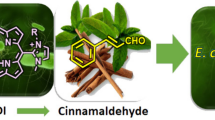Abstract
The frequency of ultraviolet(UV)-induced mutations drops rapidly whenEscherichia coli Hcr+ cells (strains WP-2 Hcr+; B/r) are incubated on phosphate-buffered agar (PBA), but is reduced only slightly if chloroquine or quinacrine are incorporated into the medium. The excision-deficient WP-2 Hcr− strain shows little reduction in the number of mutants when incubated on PBA. During postirradiation incubation on PBA, cell viability was relatively unaffected by the presence of the chemicals in the PBA (25 μg/ml quinacrine; 50 μg/ml chloroquine). When cells were given optimal doses of photoreactivating light, no further decline in mutations was obtained during subsequent incubation on PBA. Approximately 64% of the mutants seen when cells are treated with UV-PBA-chloroquine and 90% seen with UV-PBA-quinacrine can be repaired if cells are incubated on PBA. When these chemicals were added to the PBA, both excision-proficient strains (WP-2 Hcr+; B/r) demonstrated a marked reduction in the repair of UV-induced mutations to streptomycin resistance. Our results indicate that these chemicals interfere with the excision of UV-induced pyrimidine dimers, a process that normally occurs during postirradiation incubation on PBA.
Similar content being viewed by others
Literature Cited
Blodgett LW, Yielding KL (1968) Comparison of chloroquine's bonding to DNA and polyadenylic acids. Biochem Biophys Acta 169:451–456
Boyce RB, Howard Flanders P (1964) Release of ultraviolet light-induced thymine-dimers from DNA inEscherichia coli K-12. Proc Natl Acad Sci USA 51:293–300
Cohen S, Yielding KD (1965) Spectrophotometric studies of the interaction of chloroquine with DNA. J Bacteriol 240:123–131
Howard Flanders P, Boyce RP, Theriot L (1966) Three loci inEscherichia coli K-12 that control the excision of pyrimidine dimers and certain other mutagen products from DNA. Genetics 53:1119–1136
Setlow RB, Carrier WL (1964) The disappearance of thymine dimers from the DNA: an error-correcting mechanism. Proc Natl Acad Sci USA 51:226–231
Setlow RB, Swenson PA, Carrier WL (1963) Thymine dimers and inhibition of DNA synthesis by ultraviolet irradiation of cells. Science 142:1464–1466
Setlow RB, Carrier WL, Bollum FK (1965) Pyrimidine dimers in ultraviolet-irradiated polydeoxyinosine: deoxycytosine. Proc Natl Acad Sci USA 51:1111–1118
Shuster RC, Boyce RP (1964) The excision of thymine dimer from the DNA of UV-irradiatedE. coli 15 T− A− U− during thymine deprivation. Biochem Biophys Res Commun 16:489–495
Sideropoulos AS, Mruk C (1975) The role of pyrimidine dimer excision in loss of potential mutations on phosphate buffered agar of UV irradiatedE. coli. Bacteriol Proc, p H77
Sideropoulos AS, Shankel DM (1968) Mechanism of caffeine enhancement of mutations induced by sublethal ultraviolet dosages. J Bacteriol 96:198–204
Sideropoulos AS, Specht SM (1984) Evaluation of microbial testing methods for the mutagenicity of quinoline and its derivatives. Curr Microbiol 11:59–66
Sideropoulos AS, Kacsuta P, Betz MK (1980) Mutations induced by substituted quinolines in ultraviolet irradiated bacteria. Curr Microbiol 3:207–212
Sideropoulos AS, Specht SM, Jones MT (1980) Feasibility of testing DNA repair inhibitors for mutagenicity by a simple method. Mutat Res 74:95–105
Witkin EM (1964) Photoreversal and “dark repair” of mutation to prototrophy induced by UV-light in photoreactivable and non-photoreactivable strains ofE. coli. Mutat Res 1:22–36
Witkin EM (1966) Radiation-induced mutations and their repair. Science 152:1345–1362
Witkin EM, Sicurella NA, Bennet GM (1963) Photoreversibility of induced mutations in a non-photoreactivable strain ofEscherichia coli. Proc Natl Acad Sci USA 50:1055–1059
Wulff DL (1963) The role of thymine dimer in photo-inactivation of the bacteriophage T4. J Mol Biol 7:431–441
Wulff DL, Rupert CS (1962) Disappearance of thymine photodimer in ultraviolet irradiated DNA upon treatment with photoreactivating enzyme from baker's yeast. Biochem Biophys Res Commun 7:237–240
Author information
Authors and Affiliations
Rights and permissions
About this article
Cite this article
Sideropoulos, A.S., Specht, S.M. Repair inhibition of potential mutations of ultraviolet-irradiatedEscherichia coli by chloroquine and quinacrine. Current Microbiology 12, 311–314 (1985). https://doi.org/10.1007/BF01567888
Issue Date:
DOI: https://doi.org/10.1007/BF01567888




